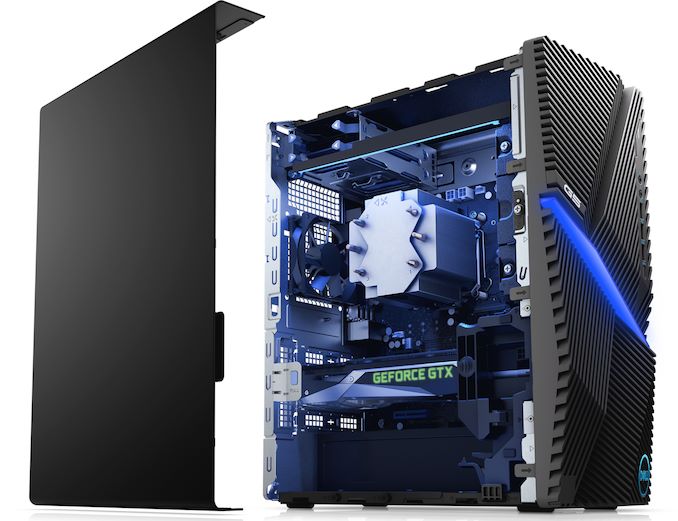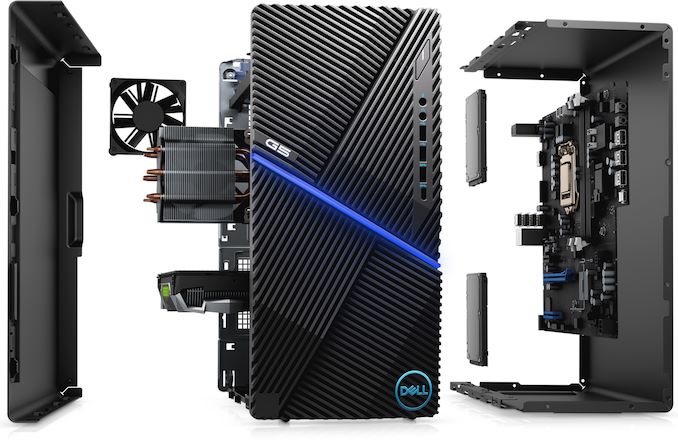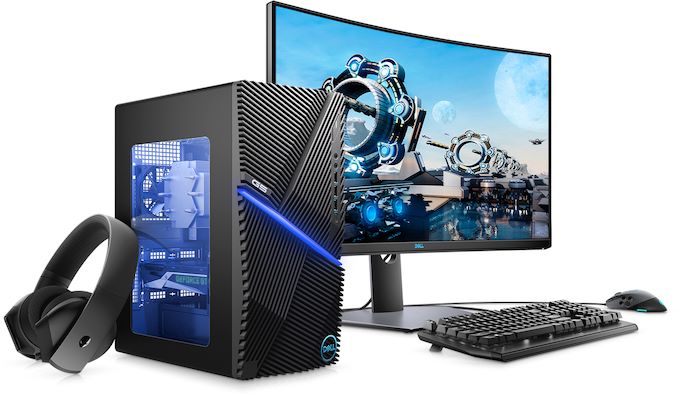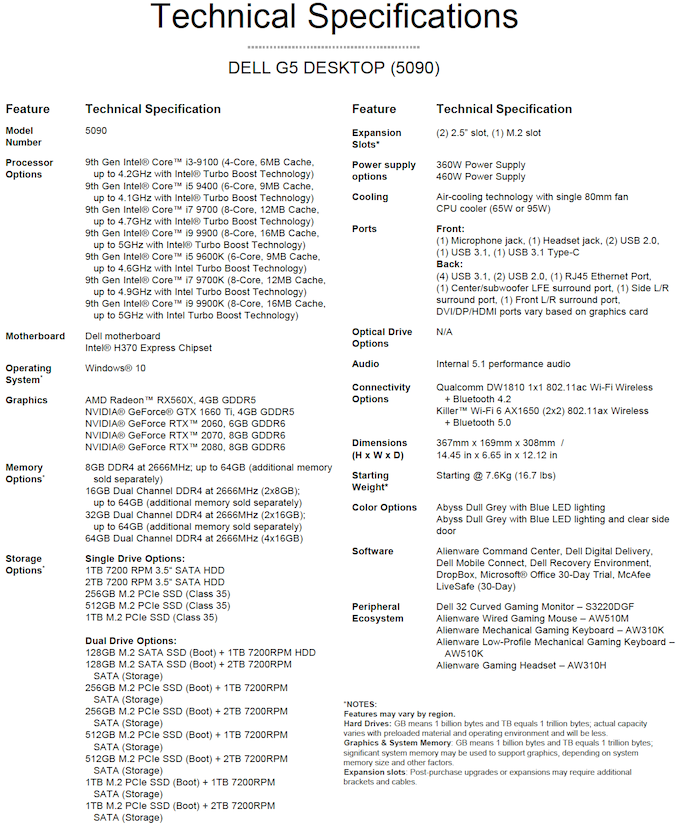Dell Unveils G5 Gaming Desktop: Starting at $629
by Anton Shilov on August 19, 2019 6:00 PM EST
Historically, Dell has addressed the market for higher-end gaming desktops with their Alienware-branded machines, which are frequently built around unlocked CPUs as well as advanced graphics cards. Meanwhile, for those who wanted Dell-branded gaming PCs without the Alienware premium, the company has offered their custom-built Inspiron as well as XPS-branded machines; though there's a large gap between the premium XPS and basic Inspiron as well. So, looking to bridge the gap between their machines and produce a line of gaming-centric yet still reasonably affordable desktops, at this year's Gamescom the company is introducing its first ever Dell G-series desktops. Taking their name from Dell's popular G5 gaming laptops – which are intended to fill much the same role on the laptop side – these new machines are intended to be Dell's gaming-focused desktops for the wider market.
The Dell G5 desktop (model 5090) is based on Intel’s 9th Generation Core processors and is paired with AMD’s Radeon RX 5700-series or NVIDIA’s GeForce GTX 1660 Ti or RTX 2000-series graphics cards. In its top-of-the-range configuration, the Dell G5 can pack Intel’s Core i9-9900K processor, NVIDIA’s GeForce RTX 2080 GPU, 64 GB of DDR4-2666 memory, a 1 TB M.2 PCIe SSD, a 2 TB hard drive (or two of them), a Killer Wi-Fi 6 AX1650 network card, Gigabit Ethernet, and so on.
Dell emphasizes that its compact G5 desktop is completely user-upgradeable, so owners will be able to easily install a new graphics card or upgrade to more storage when they need to. Meanwhile, since the machine uses a motherboard based on Intel’s H370 chipset, it does not support CPU overclocking, unlike Alienware-branded computers. The lack of overclocking support also means that Dell can stick with a (relatively) conservative 480 Watt power supply for the system, as there's no need for a bunch of overclocking headroom in the power delivery design. Overall, this is enough for a 9900K CPU paired up with one of NVIDIA's GeForce RTX 2080 video cards, but is likely a factor in why we don't see an RTX 2080 Ti here.
Unlike many gaming desktops these days, Dell’s G5 will not come with liquid cooling, but will rely on proven air cooling systems with heat pipes. Keeping in mind that CPU overclocking is not supported by the platform, air cooling should be plenty sufficient. Meanwhile, those who would like CPU and GPU to at least hit their maximum boost clocks more often can set appropriate thermal profiles in the Alienware Command Center software.
Dell’s G5 desktops will be available starting August 19. Prices will start at $629, with more advanced configurations coming in at higher prices.
Related Reading:
- Dell’s XPS 13 2-in-1 7390 Available: Intel’s 10th Gen Core CPUs Inside
- Dell Launches XPS 15 7590: Up to 5 GHz and Overclockable, 15.6-Inch OLED
- Dell Updates Alienware m15 & m17 Gaming Laptops: New Chassis, New Processors, & Optional OLED Display
- Alienware Installs NVIDIA’s GeForce RTX Cards In Aurora and Area-51 Desktops
Source: Dell













68 Comments
View All Comments
PeachNCream - Tuesday, August 20, 2019 - link
One of the outgrowths of competition in the PSU space is that people have been spending the last decade setting some unusual expectations with regards to what is actually necessary in terms of power supply output. Granted, I do agree that 460W seems a tad lean, but a 500W PSU would be perfectly adequate for the job without suffering from numbers bloat. Though, if Dell is willing to offer an extended warranty of their computer with a 460W supply, I'm pretty sure I would just get the extra warranty and not lose any sleep over the numbers.Phynaz - Tuesday, August 20, 2019 - link
AgreedRSAUser - Wednesday, August 21, 2019 - link
460W is a tad lean? A 1070 is 150W, a 3600 is 65W, then the rest of it combined maybe another 30W or so, and without taking into account that at no point will any of those parts actually all draw max at the same time as one would bottleneck the other, you'd at most need a 250W PSU, with efficiency curve at ~70%, 420W is already an overkill. Anything ~350W and more is good enough for most modern hardware, I don't understand the obsession.Even if you're going Intel with like 120W at max draw for most consumer parts, you'd still easily be able to go with a ~400W PSU.
Actually measure your power draw from the wall, then put it on a simulated max workload and check the draw, then check while running e.g. games that will pretty much never reach simulated level. 500W is overkill for anything, "modern" (I use loosely as anything pretty much post sandy bridge, 900 series/not really AMD post 200 series) consumer level.
schujj07 - Wednesday, August 21, 2019 - link
@RSAUser you are using numbers from 2 components that aren't even on the customization list. Intel i9-9900K will hit 180W, RTX 2080 is 215W with a peak of over 300W, there are blue LEDs are a few watts, and the other stuff is 30W. That will make the power draw 430W easily with possibly more requested. Not to mention this is going to be a low quality unit so this isn't a good idea of putting a 9900k and RTX 2080 into this system.sbopk - Wednesday, August 21, 2019 - link
wow awesomehttps://bit.ly/2ZPL1fZ